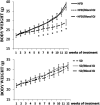Blond and blood juice supplementation in high fat diet fed mice: effect on antioxidant status and DDAH/ADMA pathway
- PMID: 35520248
- PMCID: PMC9063282
- DOI: 10.1039/c9ra00669a
Blond and blood juice supplementation in high fat diet fed mice: effect on antioxidant status and DDAH/ADMA pathway
Abstract
Non-alcoholic fatty liver disease (NAFLD) is the most common liver disease spread throughout the world. The most frequent causes of death in NAFLD patients are due both to liver and cardiovascular damage. Several pathways, including the dimethylarginine dimethylaminohydrolase (DDAH)/asymmetric dimethylarginine (ADMA) pathway, are involved in the pathogenesis of NAFLD. It has been reported that ADMA plasmatic levels are increased in patients with hepatic dysfunction such as NAFLD. Although many studies demonstrated that some foods are effective in the treatment of NAFLD, few studies have evaluated their effects with respect to the prevention of the disease. It has been reported that sweet orange juice (OJ) consumption may be associated with potential health benefits. However, some varieties of sweet orange are more effective than others. The aim of the present paper was to investigate the effect of blond and blood sweet orange juice in prevention of NAFLD by evaluating its ability to improve liver steatosis in mice with diet-induced obesity, reducing oxidative stress and affecting the DDAH/ADMA pathway. Results obtained in our experimental conditions evidenced that blood orange juice rather than blond orange juice was more effective. Blood orange juice or blond orange juice enriched in anthocyanins may represent a promising dietary option for the prevention of fatty liver disease.
This journal is © The Royal Society of Chemistry.
Conflict of interest statement
There are no conflicts to declare.
Figures









Similar articles
-
Dimethylarginine Dimethylaminohydrolase 1 Protects Against High-Fat Diet-Induced Hepatic Steatosis and Insulin Resistance in Mice.Antioxid Redox Signal. 2017 Apr 10;26(11):598-609. doi: 10.1089/ars.2016.6742. Epub 2016 Oct 20. Antioxid Redox Signal. 2017. PMID: 27565538
-
Blood orange juice inhibits fat accumulation in mice.Int J Obes (Lond). 2010 Mar;34(3):578-88. doi: 10.1038/ijo.2009.266. Epub 2009 Dec 22. Int J Obes (Lond). 2010. PMID: 20029381
-
MCD diet-induced steatohepatitis is associated with alterations in asymmetric dimethylarginine (ADMA) and its transporters.Mol Cell Biochem. 2016 Aug;419(1-2):147-55. doi: 10.1007/s11010-016-2758-2. Epub 2016 Jun 29. Mol Cell Biochem. 2016. PMID: 27357826
-
Liver plays a central role in asymmetric dimethylarginine-mediated organ injury.World J Gastroenterol. 2015 May 7;21(17):5131-7. doi: 10.3748/wjg.v21.i17.5131. World J Gastroenterol. 2015. PMID: 25954086 Free PMC article. Review.
-
Dimethylarginine dimethylaminohydrolase (DDAH): expression, regulation, and function in the cardiovascular and renal systems.Am J Physiol Heart Circ Physiol. 2007 Dec;293(6):H3227-45. doi: 10.1152/ajpheart.00998.2007. Epub 2007 Oct 12. Am J Physiol Heart Circ Physiol. 2007. PMID: 17933965 Review.
Cited by
-
Beneficial Effects of Standardized Extracts from Wastes of Red Oranges and Olive Leaves.Antioxidants (Basel). 2022 Jul 30;11(8):1496. doi: 10.3390/antiox11081496. Antioxidants (Basel). 2022. PMID: 36009215 Free PMC article.
-
Daily Orange Consumption Reduces Hepatic Steatosis Prevalence in Patients with Metabolic Dysfunction-Associated Steatotic Liver Disease: Exploratory Outcomes of a Randomized Clinical Trial.Nutrients. 2024 Sep 20;16(18):3191. doi: 10.3390/nu16183191. Nutrients. 2024. PMID: 39339791 Free PMC article. Clinical Trial.
References
-
- Boga S. Alkim H. Koksal A. R. Bayram M. Ozguven M. B. Ergun M. Neijmann S. T. Ozgon G. Alkim C. Increased Plasma Levels of Asymmetric Dimethylarginine in Nonalcoholic Fatty Liver Disease: Relation With Insulin Resistance, Inflammation, and Liver Histology. J. Invest. Med. 2015;63:871–877. doi: 10.1097/JIM.0000000000000230. - DOI - PubMed
LinkOut - more resources
Full Text Sources

